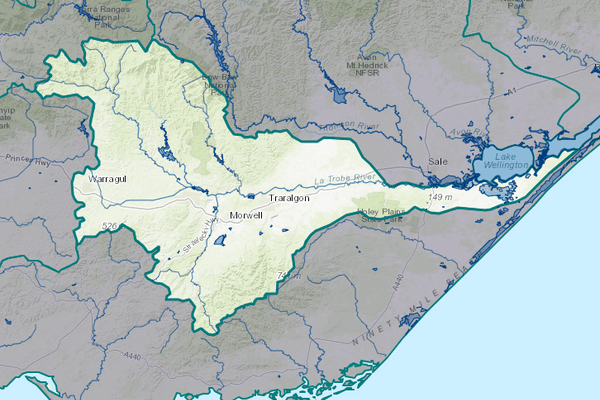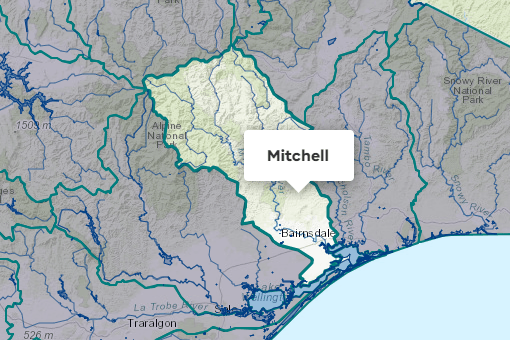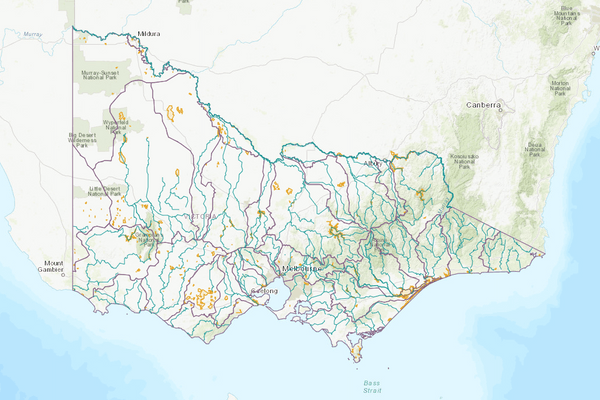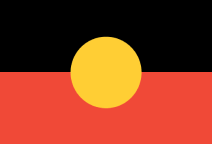About the area
The Thomson basin is in south-east Victoria. Major rivers include the Thomson and Macalister rivers, which join the Latrobe River before flowing into the Gippsland Lakes, and the Avon River, which flows directly into Lake Wellington.
The large northern section of the basin, containing the headwaters of the Thomson and Macalister Rivers, is forested and mountainous.
Annual rainfall is over 1,200 mm in the upper reaches of the basin, and reduces to between 400-600 mm in the south, which is amongst the driest area in Gippsland on average.
Water from the Thomson basin is used to supply agriculture, including a large irrigation area in the Thomson River and Macalister River valleys, as well as urban supply for the Melbourne system.
More information on water management and accounting is detailed in Water
2022-23 overview
Available water
Catchment inflow was lower than the previous year.
Licensed diversion restrictions
There were no restrictions on licensed diversions, the same as the previous year.
Seasonal determinations
Thomson-Macalister system reached 100% allocation to high- and low-reliability water shares, the same as the previous year.
Water use
More water was diverted for consumptive purposes than the previous year.
When compared to the previous year, in 2022-23:
- less rainfall was received, catchment inflows were lower and storage levels peaked and declined at similar levels
- licensed diversion restrictions were the same with no restrictions on licensed diversions from unregulated streams
- seasonal allocations were the same, with both high- and low-reliability entitlements reaching 100% allocation; spill entitlement was also available during the year
- more water was diverted from the basin for consumptive uses.
Climate
Rainfall
In 2022-23, rainfall in the Thomson basin was close to the long-term average in most areas, and lower than the previous year. Rainfall was:
- the highest recorded in the reference period (1975 to 2023) in the northern headwaters of the Macalister River
- very much above the long-term average in the west around the Thomson Dam and Baw Baw National Park, and the north of the basin
- above-average in central parts of the basin from Lake Tali Karng to Boola
- average across the rest of the basin from the Alpine National Park down to Heyfield, Sale, and Lake Wellington.
Figure 1 displays the rainfall received in 2022-23 compared to the long-term average (1975-2023).
Figure 1: Rainfall deciles, Thomson basin
Sourced from the Australian Bureau of Meteorology
River basin water balance
This section describes the known and estimated inflows, outflows and change of storage volumes in the basin.
Of the total inflows, 70% flowed out into the Latrobe River and Lake Wellington in 2022-23.
Water balance table
The table below shows the total volumes of water available and supplied from water resources in the Thomson basin in 2022-23.
Table 1: Water balance, Thomson basin
Major on-stream storages
Major - greater than 1,000 ML - on-stream storages in the Thomson basin are included in the water balance.
Storage levels
Storage levels were 94% in June 2023.
Similar to the previous year
Storage levels were 87% in June 2022.
Table 2: Storage levels, Thomson basin
Inflows
Catchment inflow
Catchment inflow represents the volume of water flowing into the waterways of a basin. It is calculated as the total outflows and change in storage minus the known inflows.
Above average inflows of 1,355,241 ML were received (145% of the long-term average of 936,400 ML), less than the previous year (184% of the long-term average).
Above average inflow
Catchment inflow was 145% of the long-term average of 936,400 ML.
Less water received than the previous year
Catchment inflow was lower than the previous year (184% of the long-term average).
Wastewater treatment plants
Water treated at wastewater treatment plants can be used to supplement water available in the basin. Water discharged to waterways from treatment plants is included as an inflow to the water balance.
Information on treatment plants is reported in the water supply local reports for the water corporation responsible for managing the plant.
In this basin, wastewater treatment plants are managed by Gippsland Water.
Outflows
Diversions
In 2022-23, 269,237 ML of water was diverted for consumptive uses: town, domestic and stock, irrigation and commercial supply. This was more than the 163,210 ML diverted in the previous year.
Small catchment dams
Water harvested, used and lost by small catchment dams (farm dams) is included in the water balance.
Table 3: Small catchment dams, Thomson basin
Entitlements and compliance
Entitlements provide the basis for how water is shared in the basin.
Melbourne Water holds a bulk entitlement to surface water from the Thomson River. This entitlement is one of four that contribute to the Greater Yarra system - Thomson River Pool, which primarily supplies Melbourne and supports regional urban water corporations, including Barwon Water, Greater Western Water (formerly Western Water), South Gippsland Water and Westernport Water. Surface water is also diverted by licensed diverters and is harvested in small catchment dams.
The VEWH holds bulk and environmental entitlements for the Thomson and Macalister rivers, respectively. Water available under these entitlements is used to support streamflows, and a small volume is diverted out of waterways to wetlands in the basin.
Entitlement volumes
Rights to water in the Thomson basin are shown in Table 4.
Entitlement volumes represent a maximum volume of water that can be taken in a one-year period. The volume available in a particular year is dependent on the rules for allocating water set out in the entitlement and the seasonal conditions in that year, which can vary. The rules for allocating water under an entitlement differ between entitlements and systems. This affects the ability and likelihood of water being taken in a particular year.
Table 4: Annual entitlement volumes at 30 June, Thomson basin
Available water and take under entitlements
Total water available under entitlements represents the volume of water that was available to be taken by entitlement holders in 2022-23. The volume includes carryover from the previous year, seasonal allocations and net trade into the basin.
Water taken
There was 297,534 ML taken under entitlements in 2022-23, more than the previous year (178,179 ML).
Seasonal allocations and restrictions on licensed diversions from unregulated rivers
- In the declared Thomson-Macalister system, high-reliability entitlement allocations opened the water year at 100% (the same as the previous year). Low-reliability entitlements reached 100% in April 2023 (a month later than the previous year). Spill entitlement was also available for use during the year.
- There were no restrictions on licensed diversions from unregulated streams in 2022-23, the same as during the previous year.
Available water and take table
This table shows the volume of available water and the volume taken under entitlements in 2022-23.
More information on available water and take has been detailed in How we account for surface
In 2022-23, more water was taken under entitlements than the previous year.
Table 5: Available water and take under entitlements, Thomson basin
Compliance
Compliance against water entitlements is reported for this basin in 3 areas:
- entitlement issued: that the volume of entitlements issued in a basin does not exceed formal caps, and has not increased without appropriate approvals
- water taken: that the volume of water taken during the year does not exceed the volume considered to be available for consumptive and/or in-stream use during that year
- bulk entitlement provisions: that holders of entitlements do not breach any provisions that are documented in their bulk entitlement orders.
Total entitlement volume
There was no net increase in the total entitlement volume from the previous year.
Total volume diverted
The total volume diverted under entitlements (297,534 ML) was within the volume available for the year (518,523 ML).
Individual bulk entitlements
No individual bulk entitlement holder took more than the annual volume made available to them.
Exceptions to compliance
Individual bulk entitlement holders complied with all provisions in their entitlements.
Water for the environment
Environmental watering sites
Environmental watering sites and environmental values in the Thomson basin that depend on water for the environment include:
- the Thomson River from the Aberfeldy River confluence to Cowwarr Weir; a heritage river reach, with high-value native streamside vegetation and high-quality in-stream habitat
- the Thomson River’s Australian grayling population
- the Heyfield wetlands, one of the few remaining freshwater wetland sites in the Gippsland Plains landscape
- the Macalister River, supporting 7 migratory native fish species, platypus and the native water rat (Rakali)
- the Gippsland Lakes, which are listed as internationally significant wetlands under the Ramsar Convention and partially rely on freshwater inputs from the Thomson basin to function ecologically.
Environmental water reserve
In 2022-23, water for the environment in the Thomson basin comprised:
- the Bulk Entitlement (Thomson River - Environment) Order 2005, which includes 3.9% share of inflows - on average, 8,000 ML a year - and 10,000 ML of high-reliability entitlement held by the VEWH and water set aside for the environment through the operation of passing flow conditions on the entitlement
- the Macalister River Environmental Entitlement 2010, which includes 12,461 ML of high-reliability and 6,230 ML of low-reliability entitlements held by the VEWH
- water set aside for the environment through the operation of passing flow conditions:
- on consumptive bulk entitlements held by Southern Rural Water
- on licensed diversions
- all other water in the basin not allocated under entitlements: this water also provides social, recreational and cultural benefits.
Environmental water use
In 2022-23, a total of 31,281 ML of environmental water was delivered in-stream in the Thomson basin.
Management responsibilities
Management of water in the Thomson basin is undertaken by various parties
| Authority | Management responsibilities |
|---|---|
| Melbourne Water |
|
| Southern Rural Water |
|
| Gippsland Water |
|
| West Gippsland Catchment Management Authority |
|
| Water supply system | 2021-22 (ML) | 2022-23 (ML) |
|---|---|---|
| Coongulla System | 43 | 0 |
| Heyfield | 199 | 255 |
| Maffra System | 1,095 | 1,026 |
| Water supply system | 2021-22 (ML) | 2022-23 (ML) |
|---|---|---|
| Macalister Irrigation District | 80,875 | 130,854 |






